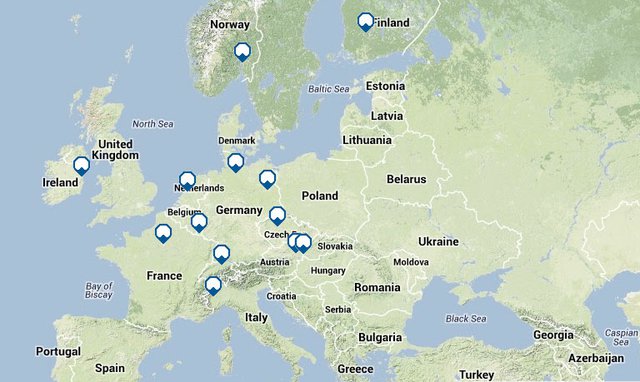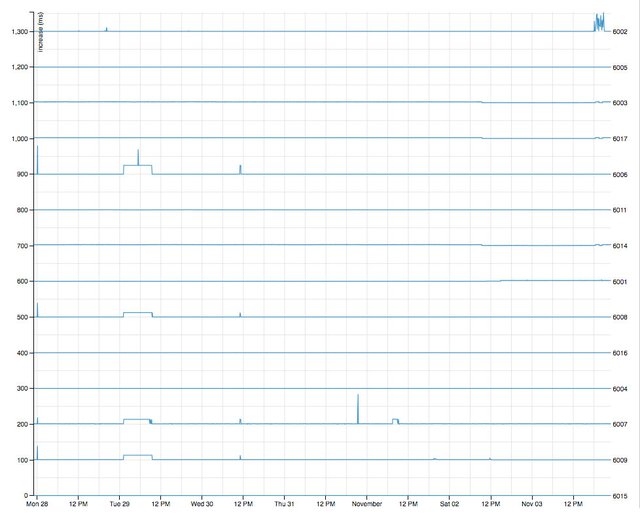RIPE Atlas anchors is now a full production service. We are actively seeking applications from those interested in and capable of hosting a RIPE Atlas anchor in their own networks. Find out what RIPE Atlas anchors are all about, the benefits of hosting an anchor, and how you can get involved.
Introduction
We're pleased to announce that RIPE Atlas anchors went into production at the RIPE 67 Meeting in Athens in October 2013. We're now actively seeking applications from those interested in and capable of hosting a RIPE Atlas anchor in their own networks. In doing so, you'll help strengthen the entire RIPE Atlas network, and gain valuable data about your own network's reachability and performance.
Ready to apply for a RIPE Atlas anchor now? You can apply here.
Background
RIPE Atlas anchors are both enhanced RIPE Atlas probes with more measurement capacity, as well as regional measurement targets within the greater RIPE Atlas network.
The RIPE Atlas anchors pilot ran for a year, and at the end of the pilot period we summarised the findings and our reasons for the hardware we selected.
At the time that RIPE Atlas anchors became a production service in October 2013, there were 15 anchors deployed. The RIPE NCC's goal is to have 50 anchors in operation around the world by the end of 2014.

Benefits of hosting an anchor
RIPE Atlas anchors provide valuable information about local and regional connectivity – both for those hosting a RIPE Atlas anchor and for the entire Internet community. In most cases, it is not necessary to send a ping or traceroute around the entire globe in order to identify problems in local connectivity – investigating regional connectivity is usually sufficient.
RIPE Atlas anchors act as well-known and co-operating targets for user-defined measurements set up by probe hosts throughout the RIPE Atlas network, in addition to supporting more of the regular measurements on the RIPE NCC perform. This includes measurements between the anchors themselves, as well as measurements involving hundreds of probes targeting each anchor. Please find more details in the measurements section below .
To recognise their service to the community, RIPE Atlas anchor hosts earn ten times the number of credits that a regular probe host earns. As an anchor host, you can use these credits to perform valuable user-defined measurements about your own network. You'll also get a more detailed overview of traffic fluctuations within the RIPE Atlas network. And we'll add your logo to our Community page and our presentations about RIPE Atlas.
Requirements for hosting an anchor
We are looking for hosts with sufficient bandwidth to support the larger number of incoming measurements that RIPE Atlas anchors must support. It is important that RIPE Atlas anchors are hosted on extremely stable networks, that they don't sit behind firewalls, and that they run on native IPv6. To date, RIPE Atlas anchors are located mainly at Internet Exchange Points and data centres.

Organisations interested in hosting a RIPE Atlas anchor are responsible for purchasing the necessary hardware and maintaining it for the period specified in the Terms and Conditions and Memorandum of Understanding . You do not have to be a RIPE NCC member to host a RIPE Atlas anchor. The RIPE NCC provides the software and firmware needed in order to connect it to the RIPE Atlas network, which is then installed by the hosts.
Get the full description of requirements and how to become a RIPE Atlas anchor host.
RIPE Atlas anchor measurements
RIPE Atlas anchors are used in several different ways within the RIPE Atlas network, as outlined below.
Anchoring measurements
The RIPE NCC schedules regular, ongoing measurements between the anchors themselves, including ping(6) measurements every four minutes and traceroute(6) measurements every 15 minutes. Together, these measurements give an overview of the health of the anchors network. Because the anchors are extremely stable, network operators can rely on these measurements to highlight objective problems within the network and can see where those problems occur.
Anchors are deployed on the open Internet and do not sit behind firewalls or any other interfering layers, and must run on native IPv6 so that transition mechanisms do not interfere with the measurements. In addition, the anchor measurements target IP addresses, meaning DNS resolution is done on the RIPE Atlas end and is not dependent on the anchor host. All of these measures are employed to ensure that the data collected is as objective as possible.
We also run regular measurements between ordinary RIPE Atlas probes and the anchors. Each anchor is measured by several hundred probes from the RIPE Atlas network in order to provide a picture of regional connectivity. The algorithms we use to determine which probes will be used to target a given anchor take into account latency, hops and ASNs in order to ensure a robust subset of probes, and geolocation data may be used in the future. We run calibration measurements everyday, and the system also checks for new anchors that have been added to the network.
The results of all these anchoring measurements are visible in the RIPE Atlas seismograph .
(Currently, users have to manually select only the RIPE Atlas anchors from the list of available probes in order to see those measurements. However, in the near future it will be possible to easily select only RIPE Atlas anchors for quick viewing.)

The results of these measurements could also be interesting to researchers looking at network events, such as investigating how routing is affected in the wake of a country-wide Internet outage. Over time, anchors will also help provide a historical record of the health of the Internet.
User-defined measurements
All RIPE Atlas users can also schedule their own measurements targeting anchors via the user-defined measurements menu in order to gain information about regional connectivity and reachability. Any host of any probe can direct the following measurements towards an anchor: ping, traceroute, DNS, SSL. You can read a more detailed description of the services running on each anchor .
The anchor names are encoded in such a way that they display their country and city location as well as the Autonomous System Number in which they are situated. This way, RIPE Atlas users get to choose from a list of regional targets in different networks and in different geographical locations. This can be extremely useful if, for example, a user wants to know how reachable their network is from Germany versus the United States, or from one ASN versus another. Ping(6) measurements are also useful for network operators wishing to test their IPv6 networks.
Get a complete list of current RIPE Atlas anchors.
Feedback
As we continue to develop RIPE Atlas, we rely on ideas, suggestions and feedback from the Internet community to help guide us and ensure we provide the tools most useful to you, the user. Let us know what you think:
- For specific questions about RIPE Atlas and anchors, please use the RIPE Atlas mailing list for active RIPE Atlas hosts and interested users, which is also followed and answered by RIPE Atlas developers: ripe-atlas@ripe.net
- For more general discussions about measurements and future plans, please use the Measurements Analysis and Tools Working Group Mailing List: mat-wg@ripe.net





Comments 0
The comments section is closed for articles published more than a year ago. If you'd like to inform us of any issues, please contact us.